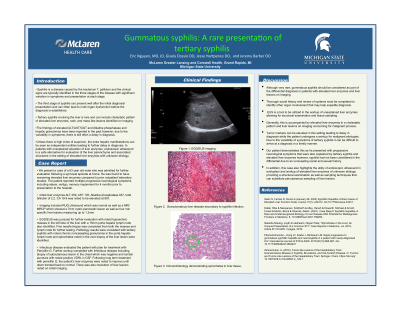Tuesday Poster Session
Category: Liver
P3916 - Gummatous Syphilis: A Rare Presentation of Tertiary Syphilis
Tuesday, October 24, 2023
10:30 AM - 4:00 PM PT
Location: Exhibit Hall

Has Audio
- GO
Gisela Ocasio, DO
McLaren Greater Lansing
Lansing, MI
Presenting Author(s)
Gisela Ocasio, DO1, Eric Nguyen, MD1, Jesse Hartpence, DO1, Jeremy Barber, DO2
1McLaren Greater Lansing, Lansing, MI; 2Corewell Health, Grand Rapids, MI
Introduction: Syphilis is a disease caused by the bacterium T. pallidum and the clinical signs are typically identified in three variable stages of the disease. The third stage of syphilis can present well after the initial diagnosis/presentation and can often lead to multi organ dysfunction before the diagnosis is established. Tertiary syphilis involving the liver is rare and can include cholestatic pattern of elevated liver enzymes, rash, and mass like-lesions identified on imaging. The findings of elevated ALT/AST/GGT and Alkaline phosphatase and hepatic granulomas have been reported in the past however, due to the variability in symptoms, there is still often a delay in diagnosis. Unless there is high index of suspicion, the extra hepatic manifestations can be seen as independent entities leading to further delay in diagnosis. In patients with unexplained elevation of liver enzymes, endoscopic ultrasound is a safe alternative for evaluation and tissue sampling.
Case Description/Methods: We present a case of a 63 year old male admitted for evaluation of syncope and found to have worsening elevated liver enzymes compared to outpatient laboratory studies. Workup prior to admission included ruling out viral etiologies, DILI based on history at onset and unremarkable social history gathered to date. Patient’s symptoms for the four months prior to admission included ataxia, vertigo, and memory impairment. Imaging included RUQ ultrasound which was normal as well as a MRI MRCP which showed a 7mm cystic pancreatic lesion as well as four non specific liver lesions measuring up to 1.2mm. No further workup had been pursued and observation with repeat imaging was recommended as outpatient. As inpatient, EUS was pursued with fine needle biopsy for further evaluation of noted hypoechoic masses in the left lobe of the liver and a 15mm porta hepatis lymph node. Pathology results were consistent with tertiary syphilis. Lumbar puncture results also confirmed concomitant neurosyphilis. Treatment with Penicillin G lead to resolution of symptoms and laboratory/imaging abnormalities.
Discussion: Although very rare, gummatous syphilis should be considered as part of the differential diagnosis in patients with elevated liver enzymes and liver lesions on imaging. Thorough social history and review of systems must be completed to identify other organ involvement that may help expedite diagnosis. EUS is a tool to be utilized in the workup of unexplained liver enzymes allowing for structural examination and tissue sampling.
Disclosures:
Gisela Ocasio, DO1, Eric Nguyen, MD1, Jesse Hartpence, DO1, Jeremy Barber, DO2. P3916 - Gummatous Syphilis: A Rare Presentation of Tertiary Syphilis, ACG 2023 Annual Scientific Meeting Abstracts. Vancouver, BC, Canada: American College of Gastroenterology.
1McLaren Greater Lansing, Lansing, MI; 2Corewell Health, Grand Rapids, MI
Introduction: Syphilis is a disease caused by the bacterium T. pallidum and the clinical signs are typically identified in three variable stages of the disease. The third stage of syphilis can present well after the initial diagnosis/presentation and can often lead to multi organ dysfunction before the diagnosis is established. Tertiary syphilis involving the liver is rare and can include cholestatic pattern of elevated liver enzymes, rash, and mass like-lesions identified on imaging. The findings of elevated ALT/AST/GGT and Alkaline phosphatase and hepatic granulomas have been reported in the past however, due to the variability in symptoms, there is still often a delay in diagnosis. Unless there is high index of suspicion, the extra hepatic manifestations can be seen as independent entities leading to further delay in diagnosis. In patients with unexplained elevation of liver enzymes, endoscopic ultrasound is a safe alternative for evaluation and tissue sampling.
Case Description/Methods: We present a case of a 63 year old male admitted for evaluation of syncope and found to have worsening elevated liver enzymes compared to outpatient laboratory studies. Workup prior to admission included ruling out viral etiologies, DILI based on history at onset and unremarkable social history gathered to date. Patient’s symptoms for the four months prior to admission included ataxia, vertigo, and memory impairment. Imaging included RUQ ultrasound which was normal as well as a MRI MRCP which showed a 7mm cystic pancreatic lesion as well as four non specific liver lesions measuring up to 1.2mm. No further workup had been pursued and observation with repeat imaging was recommended as outpatient. As inpatient, EUS was pursued with fine needle biopsy for further evaluation of noted hypoechoic masses in the left lobe of the liver and a 15mm porta hepatis lymph node. Pathology results were consistent with tertiary syphilis. Lumbar puncture results also confirmed concomitant neurosyphilis. Treatment with Penicillin G lead to resolution of symptoms and laboratory/imaging abnormalities.
Discussion: Although very rare, gummatous syphilis should be considered as part of the differential diagnosis in patients with elevated liver enzymes and liver lesions on imaging. Thorough social history and review of systems must be completed to identify other organ involvement that may help expedite diagnosis. EUS is a tool to be utilized in the workup of unexplained liver enzymes allowing for structural examination and tissue sampling.
Disclosures:
Gisela Ocasio indicated no relevant financial relationships.
Eric Nguyen indicated no relevant financial relationships.
Jesse Hartpence indicated no relevant financial relationships.
Jeremy Barber: Boston Scientific – Consultant. Pentax Medical – Consultant.
Gisela Ocasio, DO1, Eric Nguyen, MD1, Jesse Hartpence, DO1, Jeremy Barber, DO2. P3916 - Gummatous Syphilis: A Rare Presentation of Tertiary Syphilis, ACG 2023 Annual Scientific Meeting Abstracts. Vancouver, BC, Canada: American College of Gastroenterology.
